AI Content creation tools are becoming more widely available since the development of GPT-3 (and its release through Open.ai) has made AI much more accessible.
To see just how good AI writers are, we selected 10 of the best content generators and road-tested them by comparing their output on the same topic.
We ran our own mini Turing Test while testing the AI content generators.
We asked our audience if they could tell the difference between machine and human-generated content through social media polls.
Are machines taking over the content industry? Read on and find out!
How GPT-3 Is Shaking Up Content Creation
GPT-3, the language prediction model, was introduced in May 2020 and is widely available for public use through Open AI.
The quality of GPT-3 output was a huge leap forward from GPT-2 toward asking a machine to write intelligible cohesive content.
The downside to the development of GPT-3 and vastly improved content creation tools: How do you keep pace with the output of a machine?
Google has been looking at solving the potential issues of the predicted explosion of AI content to ensure their search results don’t become swamped with low-quality content.
They recently restated that AI content is against their guidelines and updated their webmaster guidelines documentation.
How can they distinguish between a machine and just badly written human content?
The progress and development of AI writers and content tools is only just getting started.
Private investment in AI more than doubled last year to $93.5 billion in 2021.
This means that more machine learning tools are being developed that will become more integrated into the tools we use as marketers and SEO professionals.
Meta recently announced a new research project into next-generation AI.
They aim to create an AI that processes data like humans and would be indistinguishable from a human.
When that might be available is not known.
Machine domination aside, in this article, we will review a selection of the current best content creation tools to see how they compare.
And consider how they can help us do a more efficient job.
Will AI take over the content creation industry? Let’s look at the results of the tools we tested.
AI Content Creation Tools Compared
We fed all the content generator tools we tested were fed the same subject matter to generate a similar length of output.
With a meta self-referential irony, we used the simple phrase, “AI content creation.”
We compared the use of the tool and the quality of the content output. You can see that output in each of the screenshots below.
As part of the comparison, we also ran all the content through Copyscape to check for plagiarism. Only one content generator was flagged with issues.
The difference in styles was most surprising about comparing the output from all the tools.
We half expected more similar results when running the same key phrase through an AI tool, but clearly, every generator has its own variables for how content is written. Much like a variety of human writers.
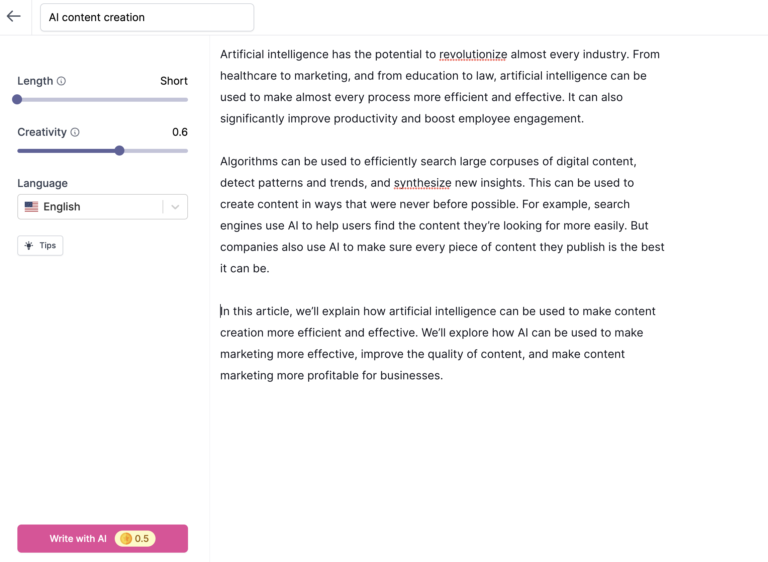 Screenshot from Writesonic, May 2022
Screenshot from Writesonic, May 20221. Writesonic
- Free version up to full unlimited price plans.
- Paid version reasonably priced.
- 24 languages.
Writesonic is built on GPT-3 and claims the machine is trained on the content that the brands using the tool produce.
The generator is based around facilitating marketing copy, blog articles, and product descriptions. The generator can also provide content ideas and outlines and has a full suite of templates for different types of content.
We found Writesonic very easy to use and it didn’t take much work to get a full article straight out of the box.
The free plan is an option to try the basic tool with the choice to upgrade to get access to full functionality.
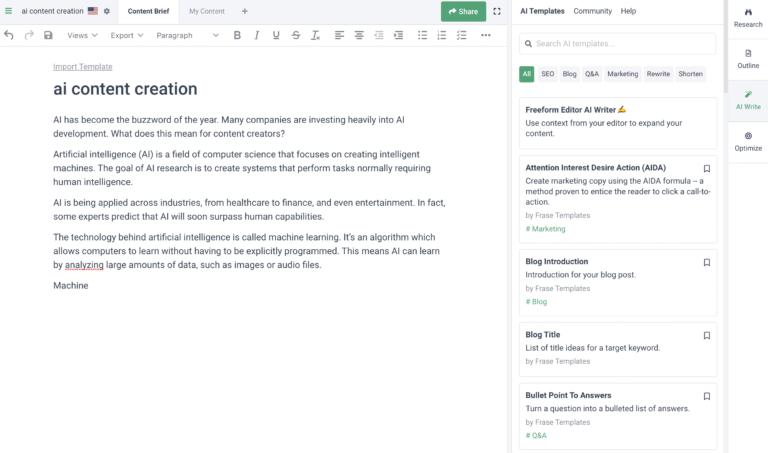 Screenshot from Frase, May 2022
Screenshot from Frase, May 20222. Frase
- Paid only.
- Cheap plans, but the credits are expensive.
Frase is a content assistant and targeted to content marketers and SEO professionals for faster and better productivity.
The tool is structured around a framework of content brief, content writing, content optimization, and content analytics.
The tool excels for research and brief outlines and the talking points tool is useful for structuring an article. A content brief can be prepared in minutes.
For content writing, the generator doesn’t produce a full article straight out of the box, and it needs some work to get the results. But, the quality of content output is high.
Frase is a useful tool for content marketers that can help to reduce the amount of time spent on writing with a competent writer in charge.
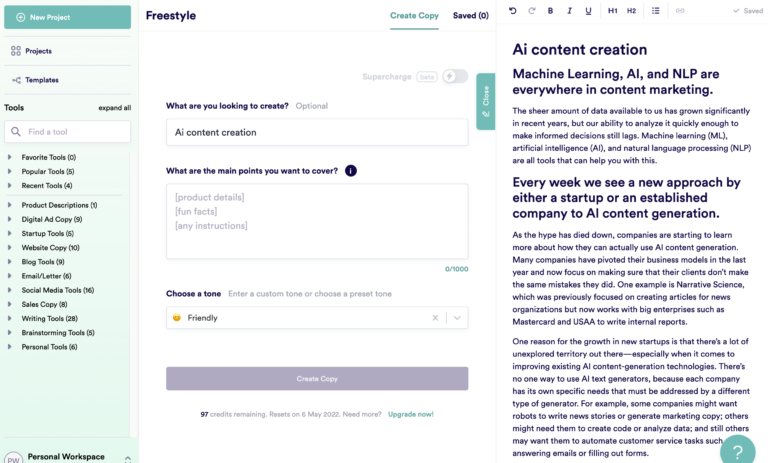 Screenshot from Copy.ai, May 2022
Screenshot from Copy.ai, May 20223. Copy.ai
- Free plan and paid unlimited.
- Paid plans very cheap.
- 25 languages.
Designed to be an antidote to writer’s block, Copy.ai is a cheap and easy-to-use content generator.
Copy.ai provides templates across various content types such as blogs, ads, sales, websites, and social media. The generator also provides translation into 25 languages.
An unusual addition to their range of tools includes a baby name generator, but we didn’t manage to get any usable results for a baby name.
Although easy to use, it’s a tool for anyone producing volume content up to an average level but not for high-end content production.
The free plan is an option to try before you buy.
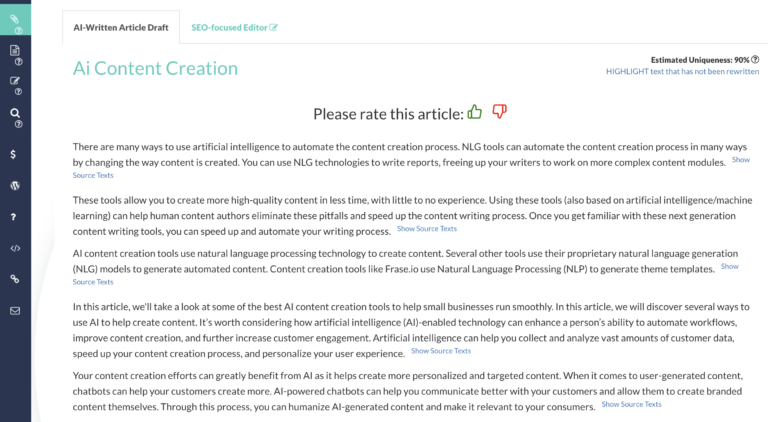 Screenshot from AI Writer, May 2022
Screenshot from AI Writer, May 20224. AI Writer
- Free trial and paid plans.
- Flagged in plagiarism checks.
AI Writer pitches itself as SEO-friendly, producing fresh and relevant copy that can save you 50% of your writing time.
From our test, AI Writer is an easy tool to use, and you get an article written within minutes.
However, it was the only tool we tested that our Copyscape plagiarism check flagged.
The articles from the writer were not the most fluid or cohesive, and felt much like an article spinner.
Out of all content generators tested, this tool didn’t feel like it was at the same standard of output as the others.
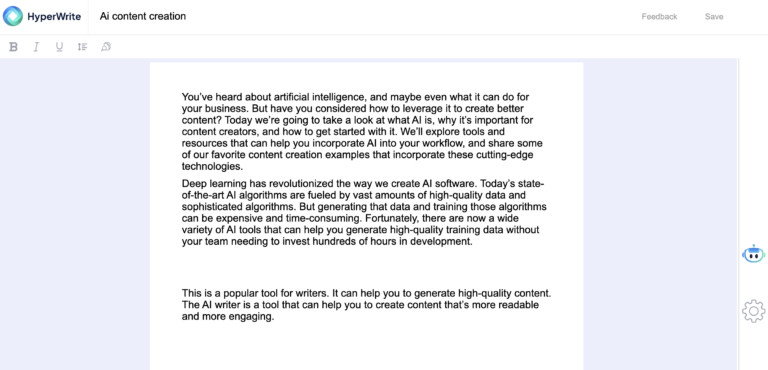 Screenshot from Hyperwrite, May 2022
Screenshot from Hyperwrite, May 20225. Hyperwrite
Hyperwrite’s claim is to use the most advanced AI generator. It’s one of the most basic tools to use and generate content and the only tool that is fully free to use.
From our test, we found the output to be surprisingly cohesive and fluid.
A useful part of the tool is that it can rewrite a sentence or make paragraphs longer to quickly restructure and build out content where needed.
The text output from Hyperwrite was the one that most people chose as being human written in our Turing Test on social media.
It’s also a free tool that offers some of the better quality of all the tools compared and is the perfect tool to test the ability and constraints of AI content generation.
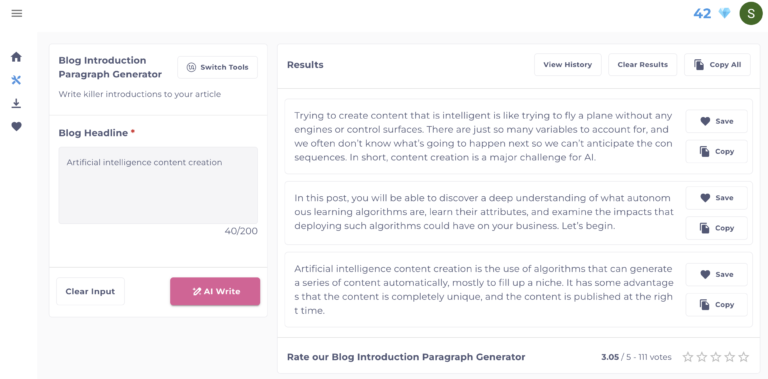 Screenshot from INK, May 2022
Screenshot from INK, May 20226. INK
- Free version and full paid plans.
- Chrome extension.
INK is another AI-powered tool targeted at content marketers and SEO experts as a content assistant for faster output and optimized content.
INK has 60 templates based around advertising, growth, website, and writing, including YouTube, pain agitation, catchy subjects, and listicles.
There’s a focus on SEO and getting content to rank with tools that support optimization and a tool scoring system to rate how well your article is optimized.
In the hands of a professional writer, INK can be a useful tool to support output, but it won’t do the job for you.
The tool took some work to get the final output, which was sometimes questionable.
INK generously offers up to 10 articles free in a month, which provides plenty of scope to try before you buy.
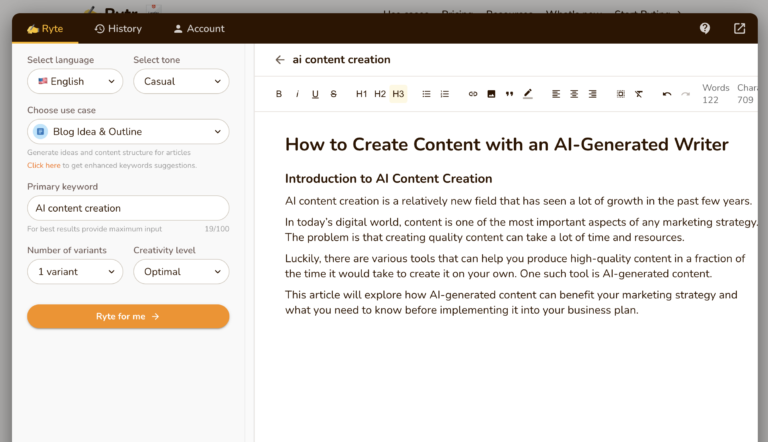 Screenshot from Rytr, May 2022
Screenshot from Rytr, May 20227. Rytr
- Free plan to unlimited plan.
- Cheap price plans.
- 30 languages.
Rytr is a full AI content generation tool built on GPT-3, emphasizing generating content that converts.
The tool has over 30 templates for marketing copy, blogs, and product descriptions. It also incorporates AIDA and PAS formulas to get the best results for copywriting.
The tool was quick and easy to use and we had a reasonable quality article in five minutes.
Rytr has a free plan with access to all the tools with a limit of 5,000 characters a month. The paid plans start very cheap if you want to progress and take more advantage of the tool.
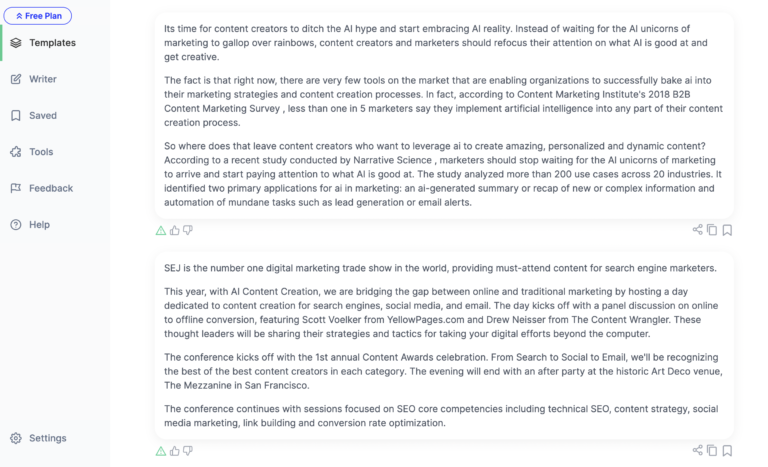 Screenshot from Smart Copy, May 2022
Screenshot from Smart Copy, May 20228. Snazzy (Now Smart Copy By Unbounce)
- Free plan to paid unlimited version.
Snazzy is powered by GPT-3 and their own proprietary machine learning to create a tool focused on landing page generation.
Unbounce acquired Snazzy and rebranded as Smart Copy and is now structured to complement and support Unbounce for seamless landing page creation.
A full range of tools are available, such as outlines, ad copy, product descriptions, and social media copy. But, the tool is pitched toward generating sales-led persuasion copy.
The results generated in our test for ‘AI content generation’ were somewhat unpredictable and not intelligible enough for an article. However, we didn’t test specifically for landing page copy.
Snazzy/Smart Copy offers a free plan with up to five credits a day to try to see if it works for you.
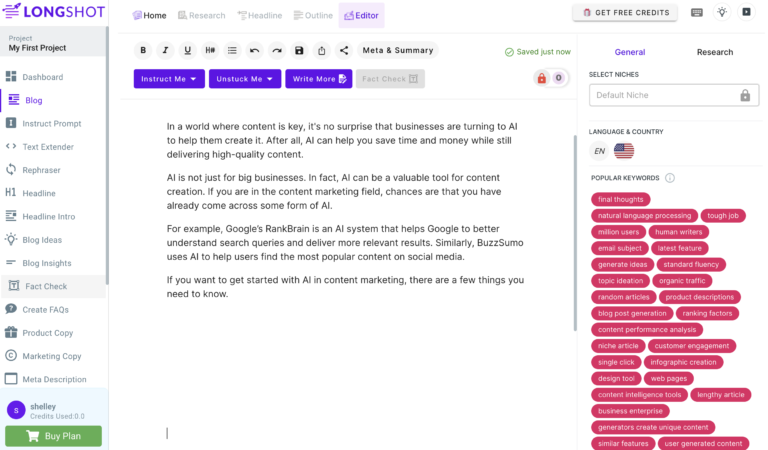 Screenshot from Long Shot, May 2022
Screenshot from Long Shot, May 20229. Long Shot
- Free version up to unlimited version.
- Eight Languages.
Long shot pitches itself as an AI-powered long-form content assistant to produce SEO-friendly content built on a combination of GPT-3 and custom AI models.
It includes over 30 tools for keyword research, rephrasing, and fact-checking, and you can write in eight languages.
From our test, we found Long Shot easy to use to produce reasonable quality content.
One interesting point: When comparing all the content output from the range of tools we tested, this was the only generator that included any brand names such as Google’s RankBrain and Buzzsumo.
This detail made the content output quite believable that it could be human-written.
Long Shot offers a free plan with up to 10 credits a day.
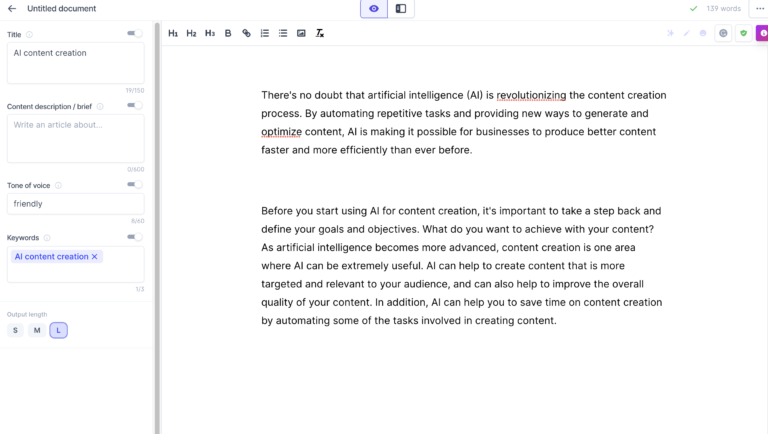 Screenshot from Jasper, May 2022
Screenshot from Jasper, May 202210. Jasper
- Paid plans only.
- 25 languages.
Jasper (previously Jarvis) claims it will help you write faster, beat writer’s block, and rank better with SEO-optimized content.
They also claim to have consulted with SEO professionals and direct marketing experts to perfect how the AI generator writes content.
Jasper has over 50 templates for producing content, including AIDA, PAS, blogs, social media, and marketing.
From our experience, Jasper is another writing support tool and not one that writes full articles without input. With guidance, the content generated from the tool is very good.
The tool is easy to use and the quality was good; however, we found the content generated was limited to short articles.
Jasper doesn’t offer any free plans, but it offers a free trial for five days.
Be aware you have to input your credit card and you will get charged if you forget to cancel.
Packages are not cheap, so you would have to max out the five-day trial to see if it was worth the investment.
The Results Of Our AI Content Turing Test
The test we ran was a simple short poll to gauge opinion and not a statistically significant result of large numbers. But, the results we found and the comments were surprising.

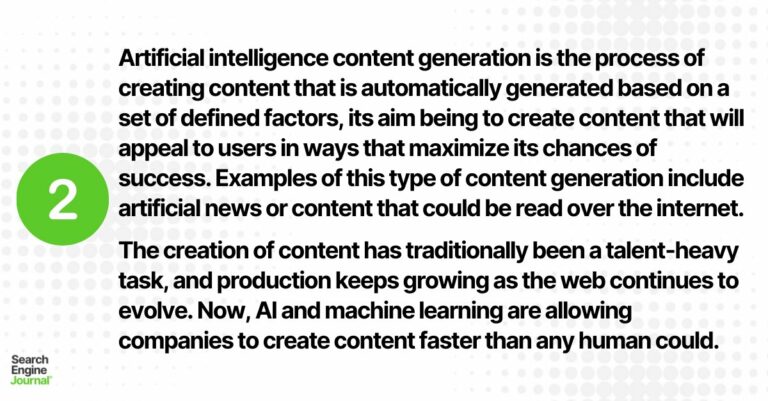
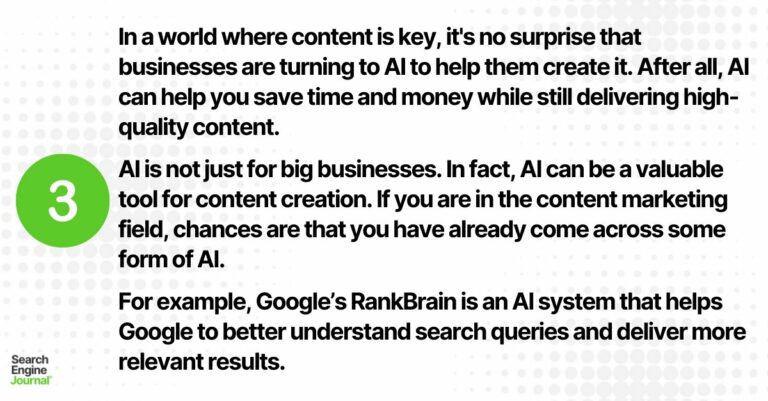
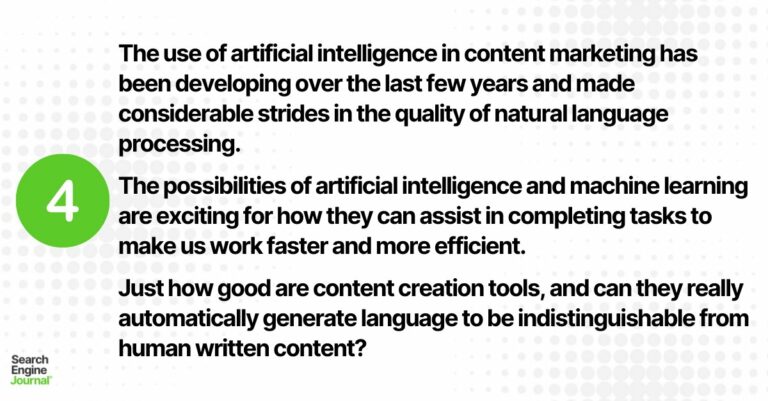
We provided three examples of 100 words of content, all based on “AI content creation” and created from some of the tools above. We wrote the fourth snippet.
We asked our audience, “Can you tell which one is human-generated?”
The short result is that no one could distinguish between AI-generated content and the human-written paragraph.
The reasons that people offered to justify those (incorrect) choices were quite interesting:
 Image from Twitter, May 2022
Image from Twitter, May 2022 Image from Twitter, May 2022
Image from Twitter, May 2022 Image from Twitter, May 2022
Image from Twitter, May 2022Out of all the comments, only a few guessed that number 4 was the human-generated copy:
 Image from Twitter, May 2022
Image from Twitter, May 2022 Image from Twitter, May 2022
Image from Twitter, May 2022 Image from Twitter, May 2022
Image from Twitter, May 2022See the full Twitter thread here.
From all responses across Twitter, Facebook, and LinkedIn, most people thought that number 1 was the human-written text.
The second text had the least amount of responses. Not surprising as this was not the best quality snippet of generated content.
The actual human-generated text was number 4 and came in third place in votes.
How You Can Use AI In Content Marketing
There’s a lot of experimentation happening with GPT-3 with plenty of fun tools being produced. But, look past these novelty applications to see where they can really have an impact.
Yes, you can machine generate your Twitter feed, but social media is about interaction and engagement.
Yes, you can write an article, but is it good enough to put your name to or represent your brand?
What needs to be considered with AI content generation is that a tool is only as good as the person operating it.
They are excellent for productivity and speeding up content production. But, you need someone who knows their subject and is a good writer behind the wheel to get results worthy of using.
A content marketer can take advantage of AI as an efficiency tool to make repetitive tasks easier and output faster.
In those terms, AI will become more and more seamlessly integrated into marketing.
Where AI Content Does Work
- For product descriptions at scale.
- For meta descriptions at scale.
- Sports results broadcasting.
- To support a writer’s productivity.
Where AI Content Doesn’t Work
- Producing well-researched content.
- Creating data-driven content.
- Having innovative and fresh ideas.
- Thought leadership.
Will AI Take Over Content Creation?
Although it’s now almost impossible to tell the difference between human and machine-generated content, the level of that content won’t win any journalist awards.
A tool cannot make up for a lack of knowledge or ability. It can only enhance it.
The machine generates content output from what is input; therefore, it only regurgitates; it isn’t creating new ideas.
It’s ideal for some tasks, but not for high-level well-researched content or thought leadership. And this is where good researchers and writers will become more valuable.
You can be assured that content creation will go into overdrive with AI.
You can also be assured that good quality journalist standard content with unique data, thought opinions, and insights will become the only way to get visibility and sustain an audience.
Who’s the winner of that game?
More resources:
Featured Image: ProStockStudio/Shutterstock
